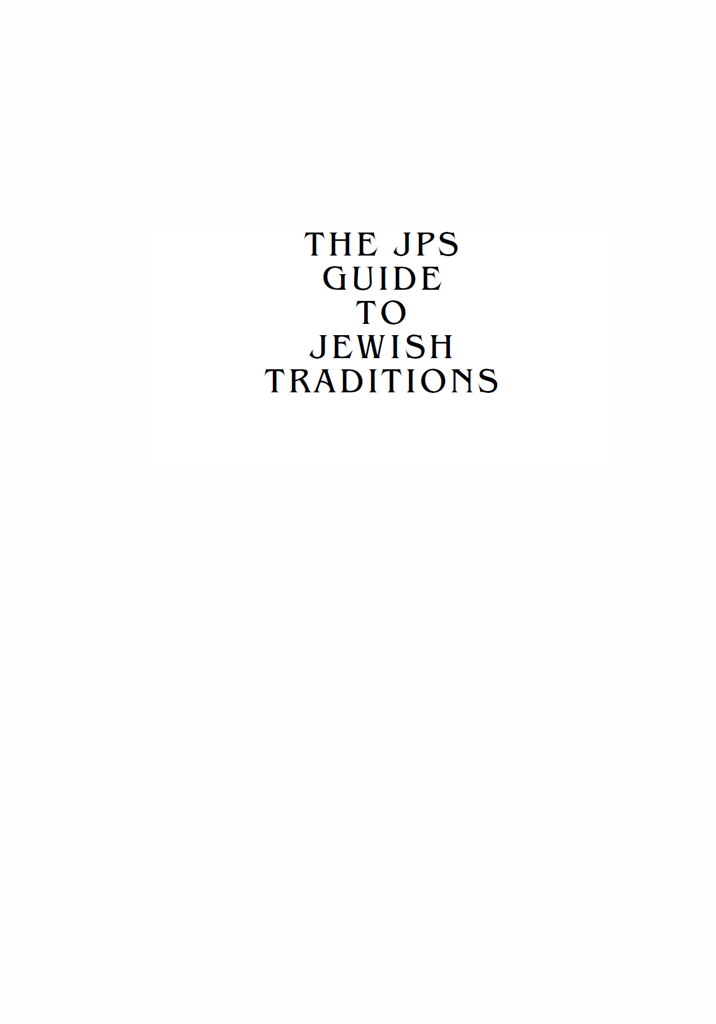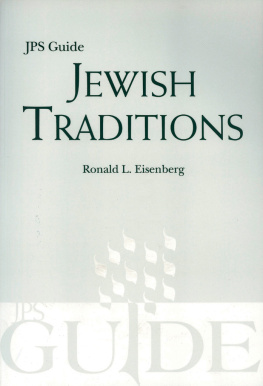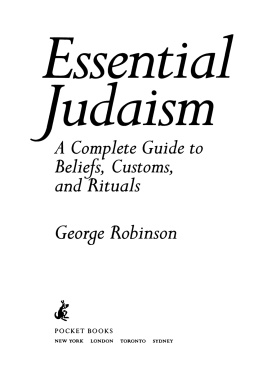Contents




Copyright 2004 by Ronald L. Eisenberg
First edition. All rights reserved.
No part of this book may be reproduced or transmitted in any form or by any
means, electronic or mechanical, including photocopy, recording, or any information
storage or retrieval system, except for brief passages in connection with a
critical review, without permission in writing from the publisher:
The Jewish Publication Society
2100 Arch Street
Philadelphia, PA 19103
Composition by Pageworks.
Manufactured in the United States of America
04 05 06 07 08 09 10 10 9 8 7 6 5 4 3 2 1
Library of Congress Cataloging-in-Publication Data
Eisenberg, Ronald L.
The JPS guide to Jewish traditions / Ron Eisenberg1st ed.
p. cm.
Includes bibliographical references and index.
ISBN 0-8276-0760-1
ISBN: 978-0-8276-1426-0 (ePub)
ISBN: 978-0-8276-1427-7 (mobi)
1. JudaismEncyclopedias. I. Title: Jewish Publication Society guide to
Jewish traditions. II. Jewish Publication Society. III. Title.
BM50.E49 2004
296.4dc22
2004006399
The publisher does not have any control over and does not assume any responsibility for author or third-party websites or their content.
Acknowledgments
We gratefully acknowledge the following publishers for their kind permission to reprint material from their works:
Dietary Laws: reprinted with permission from The Jewish Dietary Laws by Samuel Dresner and Seymour Siegel. Copyright 1982 by The Rabbinical Assembly.
Marriage Ceremony; and Memorial or Headstone: reprinted with permission from Teaching Jewish Life Cycle: Traditions and Activities by Barbara Binder Kadden and Bruce Kadden. Copyright 1984 by A.R.E. Publishing, Inc., 1997. A.R.E. Publishing, Inc., Denver, CO. 800-346-7779, www.arepublish.com.
Maimonides Thirteen Principles of Faith; Vidui; and text of various blessings reproduced from ArtScroll Siddur Kol Yaakov with permission from the copyright holders ArtScroll/Mesorah Publications, Ltd.
Aninut : reprinted from The Jewish Way in Death and Mourning by Maurice Lamm. Copyright 2000. By arrangement with Jonathan David Publishers, Inc., Middle Village, NY 11379. www.jdbooks.com.
Premarital Sex: reprinted from The Jewish Way in Love and Marriage by Maurice Lamm. Copyright 1991. By arrangement with Jonathan David Publishers, Inc., Middle Village, NY 11379. www.jdbooks.com.
Dietary Laws, and Prohibitions of Work on the Sabbath: reprinted with permission from Exploring Jewish Tradition by Abraham B. Witty and Rachel Witty. Copyright 2001. Doubleday, Random House, Inc.
Material adapted for the section on Torah Ornaments: reprinted with permission from The Encyclopedia of Jewish Symbols edited by Frankel and Teutsch. Copyright 1992. Published by Jason Aronson.
Material adapted for the section on Women and Mitzvot: reprinted with permission from Women and Jewish Law by Rachel Biale. Copyright 1984 by Schocken Books, Inc. Used by permission of Schocken Books, a division of Random House, Inc.
Material adapted for the section on Superstitions: reprinted with permission from The Book of Jewish Customs by Harvey Lutske. Copyright 1986. Published by Jason Aronson.
To my wife Zina,
and to our daughters
Avlana Kinneret and Cherina Carmel,
whom we pray will continue to embrace their Jewish tradition
and will transmit it with love to the next generation
Preface
The JPS Guide to Jewish Traditions originated from my own search for answers to questions relating to a variety of Jewish issues, and thus it is ultimately a book that I wanted to read. As proven by my own experience, I am convinced that many Jews could gain a substantially greater spiritual satisfaction from the rituals and life-cycle events they observe by understanding the profound meanings underlying them. This is somewhat analogous to reading the prayers in Hebrew. Only with a grasp of the language can one fully appreciate the depths of the prayers; only with the knowledge of how the prayers developed and interrelate can one see the brilliance and inspiration of the sages who wrote them.
The book opens with a discussion of the major life-cycle events, encompassing the first 16 years of life, from birth through confirmation, marriage, and death. The next major section deals with the Sabbath and festivals, detailing the historical development of this superstructure of the Jewish year. This is followed by a section on synagogue and prayers, which afford Jews the opportunity for a formalized approach to a relationship with the Divine. The next major topics are the Bible and rabbinic literature, the written and philosophical cornerstones of Jewish belief; and the mitzvot, which detail the prescribed daily activities and the ethical value system that are the essence of traditional Jewish behavior. Following a discussion of symbols of Judaism and the State of Israel, there are alphabetically arranged sections on a broad spectrum of topics of Jewish interest that do not conveniently fit into any other area. The final parts of the book deal with the role of food in Jewish tradition and daily life, as well as those plants and animals that are mentioned in the Bible and Talmud. For the convenience of the reader, the appendix contains a listing of the Torah and haftarah readings for Sabbaths and festivals as well as a listing of the tractates of the Mishnah and their major topics. Bible passages quoted throughout the book are most often from The Jewish Publication Society translation (NJPS). My preferred translations are noted accordingly in the endnotes.
I want to thank Rabbi Robert Layman, former Regional Director of the United Synagogue of Conservative Judaism; Candace Levy; and Daniel Septimus for their valuable editorial contributions. I would like to acknowledge Professor Byron Sherwin at Spertus Institute in Chicago, whose superb lectures have been the source of my inspiration to pursue my writings in Judaica. I gratefully appreciate the ceaseless efforts of Carol Hupping, publishing director at JPS, who displayed unswerving dedication to making this project a reality. I also wish to thank the following people at JPS who have contributed their efforts and talents: Janet Liss, production editor; Robin Norman, production manager; and Jamie Temple, designer and typesetter. Immeasurable gratitude is due to my wife, Zina Schiff, who not only read the manuscript carefully and posed challenging questions, but also has created the ideal Jewish environment in which to write this book.
I hope that the reader will share the joy I felt while delving deeply into the fascinating richness that constitutes the traditions of the Jewish people.
Ronald L. Eisenberg
June 2004
Language
No knowledge of Hebrew, Aramaic, or Yiddish is required to use this book, since all words in these languages are transliterated into English. Transliteration is a difficult task, because the sounds of one language often cannot be reproduced precisely in another. The basic guidelines used in this book are as follows:
| a | as in f a ther (shalom, baruch ) |
| e | as in m e n ( lechem , beracha ) |













